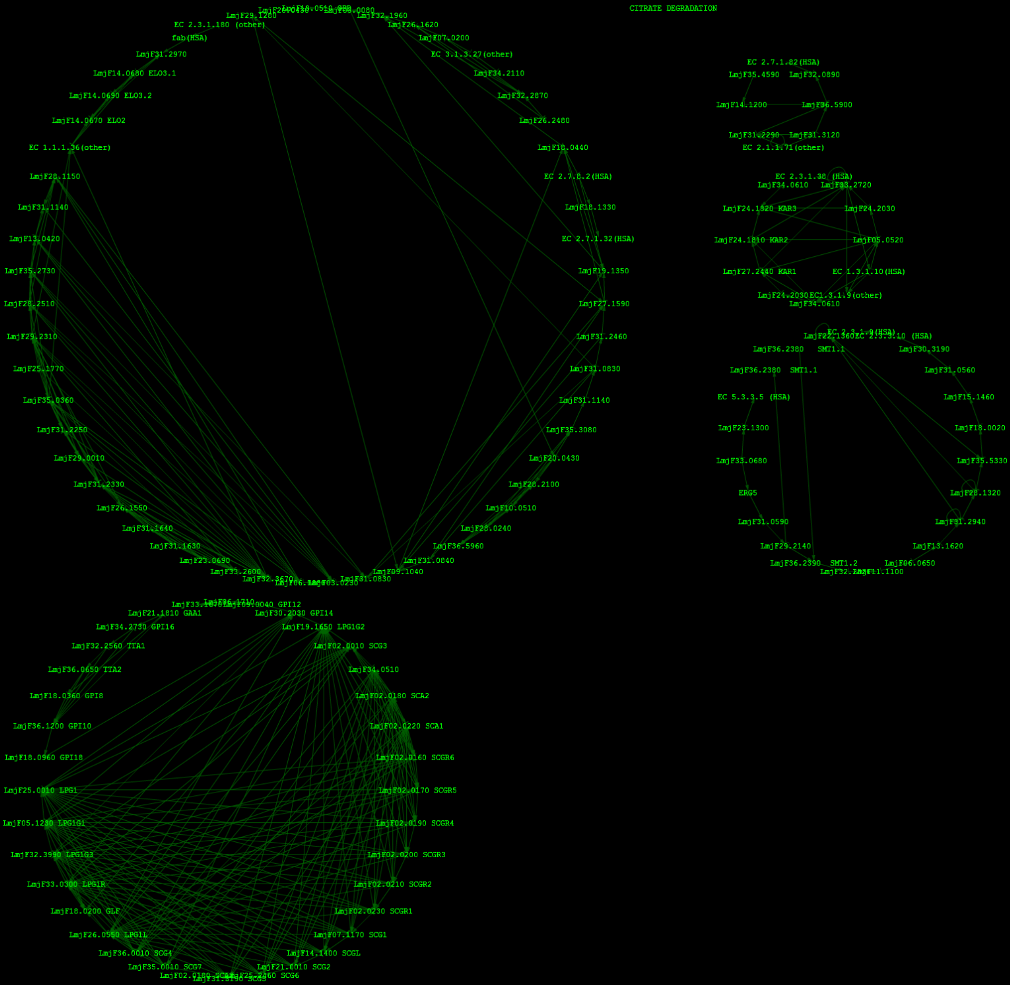About LmSmdB:
This site presents data integration, analysis and managing environment for systems biology research for studying Gene Regulatory Network and Simulation of metabolic network engine. We developed methods and tools for simplifying and streamlining the process of integration of molecular interaction, genome sequences, and protein structure information for pathogen-related studies. Systems level studies on Leishmania major and Schistosoma mansoni identified molecular pathways that appear to be targeted during infection, and these results highlight pathways exhibiting responses specific for a given pathogen infection.
Different Metabolic and Regulatory Networks:
The database demonstrates the usefulness of dynamic data integration techniques to enable a hypothesis generation platform for major human disease systems. Identifying a drug target and modeling a disease network is straightforward if there is conservation between two species. This conservation between the species helps to search the homologues and orthologues in a model organism.
Here, We present the different metabolic and regulatory networks in L.major and S.monsoni mentioned as below;
- Protein interaction network of lipid metabolism in L.major
- Circular layout of GPI,GIPLs and LPG
- Regulatory Networks in L.major and S. monsoni and its Biochemical modelling
| Metabolic Pathway | LPG Biosynthetic Pathway | Protein Details | System Biology |
|---|
Cellular overview of LPG Biosynthetic Pathway with respect to the sub-cellular localization --- Click Here
Protein Details
Subcellular location of Enzymes
Glycerophospholipid Metabolism in Schistosoma mansoni
| Sr.No. | Enzyme Name | Gene No. | TMHMM Domains | Location |
|---|---|---|---|---|
| 1. | Sn-glycerol-3-phosphate:NAD + 2-oxidoreductase | Smp_030500.1 | - | Cytosol |
| 2. | Sn-glycerol-3-dehydrogenase(FAD dependent) | Smp_121990 | - | Mitochondria |
| 3. | Acyl-CoA:1-acyl-sn-glycerol-3-phosphate-2-o-acyltransferase | Smp_000070 Smp_079860.2 Smp_173790 |
2 7 10 |
Integral to Membrane |
| 4. | 1,2-Diacyl-sn-glycerol-3-phosphate phosphohydrolase | Smp_171720 | 6 | Cell Membrane |
| 5. | ATP:1,2-diacyl-sn-glycerol-3-phosphotransferase | Smp_036180 Smp_131190 Smp_163080 |
- | Cytosol |
| 6. | Phosphatidylcholine/ethanolamine phosphatidohydrolase | Smp_151420 | - | Golgi apparatus |
| 7. | Phosphatidylcholine/ethanolamine acyltransferase | Smp_133290 | - | Cytosol |
| 8. | Acyl-CoA:1-acyl-sn-glycero-3-phosphocholine/ethanolamine o-acyltransferase | Smp_1332850.1 Smp_169040 |
1 3 |
Cytosol Integral to membrane |
| 9. | 2-Lysophosphatidylcholine acyltransferase | Smp_166530.2 Smp_171820.1 |
- 1 |
Cell inner membrane |
| 10. | Acetyl-coA:choline o-acetyltransferase | Smp_146910 | - | Nucleus |
| 11. | Choline/Ethanolamine phosphotransferase | Smp_015030 Smp_132570 |
- | Cytosol |
| 12. | (a). CTP:Choline-phosphate cytidylyltransferase (b). CTP:Ethanolamine-phosphate cytidyltransferase |
Smp_124730 Smp_132570 |
- | Cytosol Cytosol |
| 13. | CDP-Ethanolamine:1,2-diacyl-sn-glycerol ethanolamine phophotransferase | Smp_071020 | 9 | ER membrane |
| 14. | ATP:Ethanolamine-O-Phosphotransferase | Smp_015050 | - | cytosol |
| 15. | CTP:phosphatidate cytidylytransferase | Smp_144030 Smp_177410 |
7 2 |
Integral to membrane |
| 16. | Phosphatidylserine decarboxylase | Smp_021830 | - | Cytosol |
| 17. | CDP-diacylglycerol:sn-glycerol-3-phosphate 3-phosphatidyltransferase | Smp_090820 | - | Cytosol |
| 18. | 1-Acyl-sn-glycerol:sn-glycero-3-phosphoethanolamine aldehydohydrolase | Smp_166530.2 Smp_171820.1 |
- 4 |
Nucleus |
| 19. | CDP-diacylglycerol:myo-inositol 3-phosphatidyltransferase | Smp_132640 | 4 | Membrane |
System Biology Network of L.major Genes
Systems Biology aims to develop mathematical models of biological systems by integrating experimental and thereotical technique by leveraging on the genome wide data to unravel the complexity of gene regulation. Despite the availability of effective chemotherapy,Leishmaniasis and Schistosomiasis continue to be one of the major parasite infections to affect the human population worldwide. Little is known about the structural biology of the parasite that are responsible for the disease and few attempts have been made to develop second generation drugs, which may be essential for MDR.

Multiscale modeling and simulation techniques permit us to study the spatial and temporal properties the large system to be simulated atomic detail structures.The estimation of kinetic parameters for mathematical modeling provides a basis of iterative manipulation of biochemical pathway.
The focus, lead on the evaluation of the model by emphasizing on the prediction behaviour of GRN and also whether it represents the structure of the system. Prediction versus recall curve analysis provide to be useful components for performance evaluation of the built GRN for S.mansoni and L.major.

.jpg)